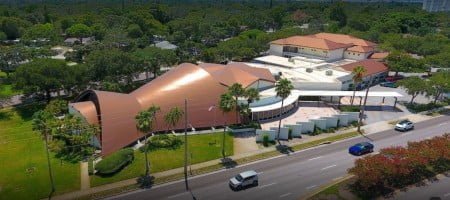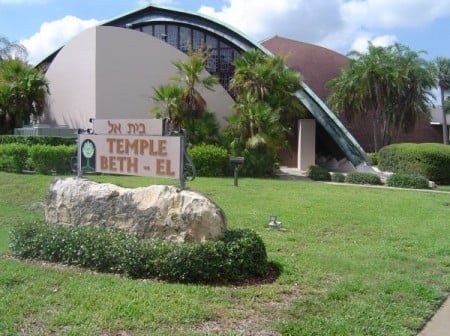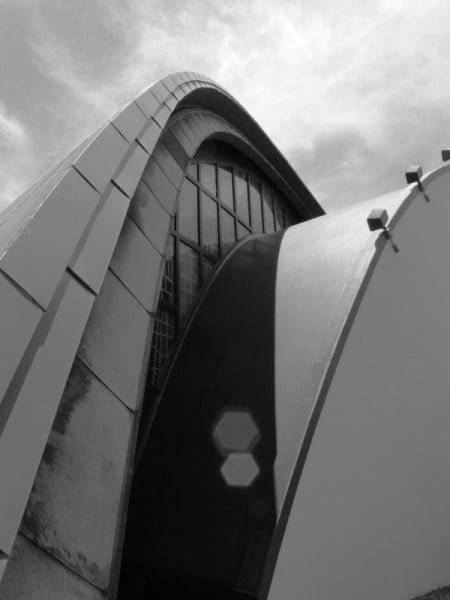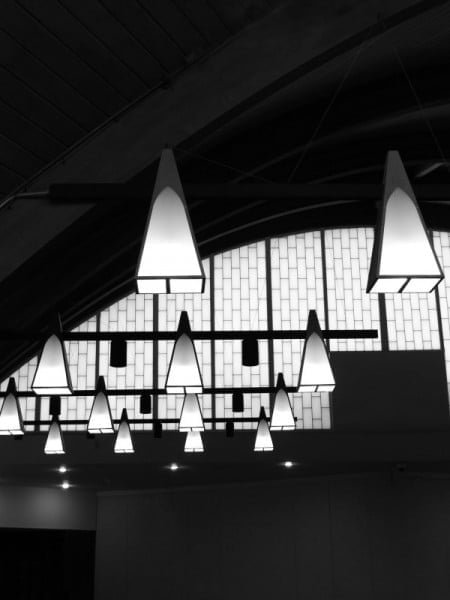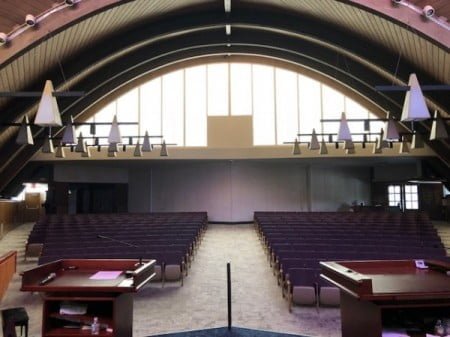Temple Beth-El
LOCATION: 400 Pasadena Ave S, St. Petersburg, FL 33707
ARCHITECT: Morris Lapidus
BUILT: 1961
SIZE: –
ORIGINAL FUNCTION: Synagogue
PHOTO CREDITS: Synagogues360.com
ABOUT THE PROJECT:
Temple Beth-El was built in the early 60’s and was designed by architect, Morris Lapidus. Lapidus is most well-known for his 1950’s tropical modern hotels on Miami Beach including The Fontainebleau, Algiers and Eden Roc Hotels. He is known for whimsical details like curved glass walls and nonlinear shapes, like the main 350 seat sanctuary at Temple Beth-El
ABOUT THE ARCHITECT:
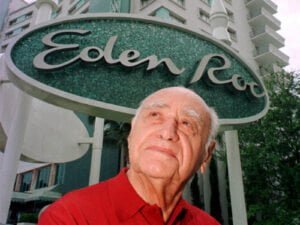 Morris Lapidus was born in Odessa, Russia in 1902. In 1903 his Orthodox Jewish family immigrated to the United States living in New York City. As a young man he set out to study and pursue a career in acting. Instead he was drawn to scenic design and in the 1920’s he attended Columbia University’s School of Architecture, graduating in 1927. He was fascinated by European modernism and architects like LeCorbusier and Mies van der Rohe. However it is said that his design sensibility was shaped by his early exposure to life in New York tenements and trips to Coney Island.
Morris Lapidus was born in Odessa, Russia in 1902. In 1903 his Orthodox Jewish family immigrated to the United States living in New York City. As a young man he set out to study and pursue a career in acting. Instead he was drawn to scenic design and in the 1920’s he attended Columbia University’s School of Architecture, graduating in 1927. He was fascinated by European modernism and architects like LeCorbusier and Mies van der Rohe. However it is said that his design sensibility was shaped by his early exposure to life in New York tenements and trips to Coney Island.
His early career included roles in designing building ornamentation and retail storefronts. He continued designing unique modern storefronts for 15 years until he opened his own firm and soon earned a commission to design the San Souci hotel in Miami Beach. His unique designs meant to maximize the enjoyment of hotel guests soon earned him a number of hotel commissions in Miami Beach including the Algiers, The DiLido, Nautilus and the most famous, the Fountainebleau. In retail, he designed to sell merchandise, in hotels he designed to “sell a good time”. Sweeping curves, theatrically backlit floating ceilings, ‘beanpoles’, and the ameboid shapes that he called ‘woggles’, ‘cheeseholes’, as well his adept use of color, signage, lights, mirrors, techniques to “float columns”, float stairs and move people along meandering lines are all Lapidus’ signature design elements.
His designs were clearly a hit with the public, however in the prime of his career he did not earn the respect of his architecture colleagues. His designs were described as gaudy and kitsch. This abusive critical reception perhaps culminated in a 1963 American Institute of Architects (AIA) meeting held at the Americana, where a variety of well-known architects including Paul Rudolph, Robert Anshen and Wallace Harrison took Lapidus to task for what they described as vulgarity, cheapness, and incompetence.
From 1993 until his passing in 2001, Lapidus’ style became more appreciated than ever. It was during this time that he had a collaborative relationship with architect and artist Deborah Disilets. They worked on design as well as publicity, giving many interviews and lectures. After the renewed interest, Lapidus was quoted saying, “I never thought I would live to see the day when, suddenly, magazines are writing about me, newspapers are writing about me!”. His clients and the people were cheering for him at a Cooper-Hewitt party when Lapidus exclaimed; “feelings find form.” debunking the Bauhaus’s “form follows function” approach to design.
Morris Lapidus died in 2001 at the age of 98 in his Miami Beach apartment. Much of his remaining work was donated by Deborah Disilets to Syracuse University Special Collections to preserve his legacy.
MORE PHOTOS:
